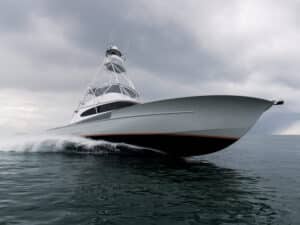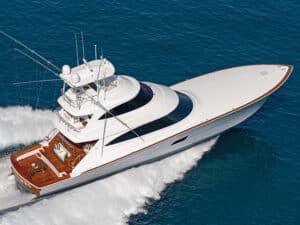





Some of you might remember that I did a review on the 80-foot Weaver Islamar almost two years ago. I was more than impressed with the styling and performance of this incredible fishing machine, so I was a bit concerned when asked to do a review of the current 80 Weaver Escapade that just recently splashed. How different could this boat be from the previous 80?
After a brief conversation with Escapade‘s captain, Jeff Smith, I learned of a number of differences, so my concerns quickly faded. Two main features really piqued my interest, though: the addition of prop pockets or tunnels to minimize draft and the new 2,600-hp MTU engines.
As I walked up to the boat while it sat behind the owner’s house in Palm Beach, Florida, I didn’t notice any outward changes from the previous 80. She shared the same sleek sheer and styling as the other boat, with the exception of a Stars-and-Stripes, blue-colored hull, a 1500 MarQuip lifting davit with cradles for a bonefish skiff and a pulpit with a custom stainless-steel anchor.
As I boarded, I noticed a varnished-teak bulkhead. I am not a big fan of varnished teak on a boat because I have spent -thousands of hours stripping and refinishing it, but it sure is beautiful. In this case, it really set off that classic, rich feel to the cockpit.
Performance
I opted to leave the dock first thing to see how she was going to run with the big engines. I’d never been on a sport-fishing boat with as much horsepower. Capt. Smith brought along his wife and two young sons to act as crew, so all I had to do was take a seat on the bridge while they threw all the lines off. With a tap of the bow thruster, combined with a few bumps in and out of gear, we were headed to the inlet. As we approached a couple of marinas, I noticed we did not throw as much wake as other boats this size.
As we passed one marina, Smith pulled one engine out of gear and motored on a single engine. This further reduced an already small wake without losing much steering control. It’s great that you don’t need to manhandle the wheel and play with the throttles while on one engine to keep it headed in a straight line. It’s even more important to know that the boat can turn easily while trolling on a single engine as well, and this boat turned smoothly with a very clean wash.
Once out of the inlet, Smith pushed the throttles up and the boat planed out fast and free of cavitation, absolutely smooth with zero vibration. A number of tunnel-hull boats seem to have issues with cavitation, noise and vibration, but this one didn’t. The steering response at speed was a little slower than the non-tunnel boat, but it was responsive enough to dodge any on-coming situation. With 1,000 gallons of fuel on board, we topped out at 45 knots very quickly — faster than I was expecting, with the water temperature in the high 80s and air temperature in the 90s. I am sure on a cooler day you could see 46 or 47 knots with no problem.
While cruising along at 36 knots at 1,950 rpm, you could really appreciate the three large Garmin 19-inch touch screens in the helm console. The boat I run does not even top out at 36 knots, but if it did, I would need to have these giant screens to easily and quickly see important info at a glance while traveling at these speeds! I also liked that the three monitors were side by side with nothing else around the displays — a very clean look. All the -buttons or extra controls for the units sat in a recessed pocket next to the helm pod for easy access, so you don’t need to take your eyes off the water.
Turning
After our blistering run followed by a little cruising along the coast, Smith slowed the boat down to idle and gave me the wheel._ Islamar_ backed up and spun like a production 60-footer, so I was really interested in what this boat was going to do with the tunnels and the 2,600 hp. I started out easy, going into gear without throttle, and the boat went back with a decent amount of speed and no vibration. Then I started to increase to full throttle in reverse. With the throttles pinned all the way down, the tunneled hull did not dig down and take on tons of water. This was a noticeable -difference from the non-tunnel boat. I tried a spin with the wheel hard over, with one engine forward and the other in reverse at full throttle. She spun around quick without an excessive amount of cavitation — not as fast as Islamar as I remember, but very close. Since Escapade drafts about 8 inches less, I would go for the boat with the tunnels.
Engine Room
After the excitement from the ride wore off, I realized I should have gone into the engine room before we went for the boat ride. Islamar and a few other Weaver boats I had been on all had impeccable engine rooms. They have all been perfect, so I was not worried about the fit and finish. I really wanted to see the two gyrostabi-lizers from Seakeeper — even though they were not on during this test, I still wanted to see where they found space for them. To my amazement, they were perfectly placed in the forward part of the engine room on the outboard side. It was almost like they designed the boat around them. They were easily accessible, as was all the other engine room equipment, the way an engine room should be.
Below
The interior and layout of this boat was not unlike that of the other 80. All Weaver interiors are masterfully crafted by Larry Belkov and his team. This boat boasts a beautiful, contemporary-styled satin varnished-teak interior. The layout -mirrors the other boat with five staterooms and five heads below, with a day head just inside the salon door. As you could imagine, a jaunt to a head up forward in a boat of this size could take you out of the fishing game for some time.
This is an incredible boat. It’s fast and beautiful, boasting tons of space for storage, with all the redundant features needed to travel and fish anywhere in the world you want in comfort with plenty of accommodations for crew and six guests. I would love to run a boat like this on long ventures.
I do have one complaint. The helm pod is too high for a guy my height (5’8″) and too narrow. It’s fine for running forward, but when you have to turn your back to the console to chase fish around, you could be standing there for a long time. For the short time I spent backing the boat, I was very uncomfortable. I would lower the pod a few inches and widen the distance between the control handles. In the end, I remembered that Jim Weaver builds a complete custom package from the bottom up to accommodate his client’s needs and desires, so I am sure I could get that console made to fit me perfectly if I were involved with a build. As Capt. Smith said: With not much more than a spit and a handshake, you get what you want at Weaver, on time and on budget.







